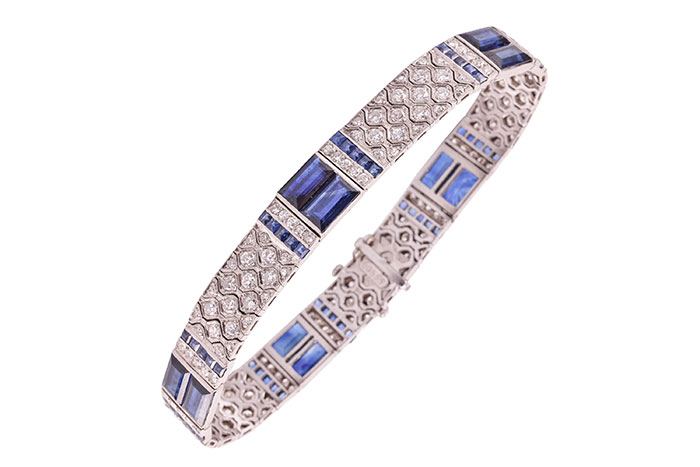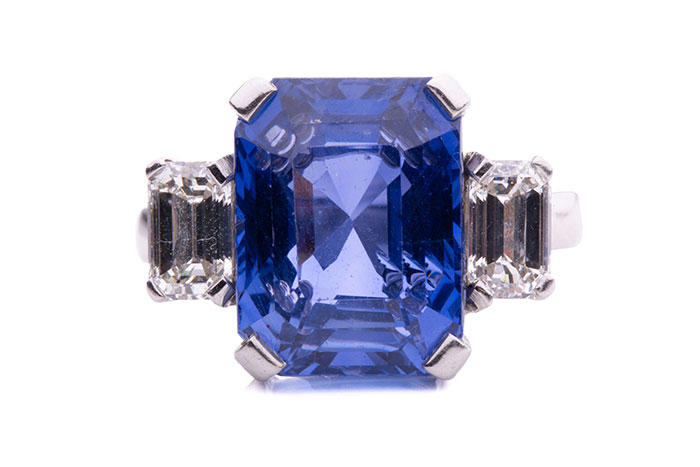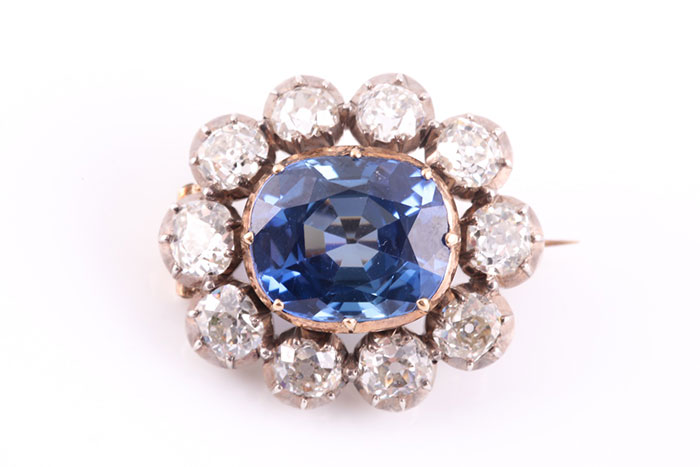How to Tell if a Sapphire is Real
A few tips to help confirm the authenticity of a suspected sapphire…
22/07/2024
As one of the most coveted and valuable gemstones, sapphires from the corundum family are incredibly popular across the globe, featuring prominently in jewellery that has been crafted for royalty and nobility for centuries. Considered a symbol of love and wealth, the sapphire is also the birthstone for September.
An Art Deco sapphire and diamond line bracelet
The most common misconception about sapphires is that they are all blue. Whilst they come in a variety of blue shades, sapphires also naturally come in a range of colours including pink, orange, yellow, green, violet, purple and colourless (white). A rare type of sapphire, padparadscha sapphire, is pinkish orange.
Not surprisingly, due to the increasing in demand, sapphires and rubies were some of the first gemstones to be synthesized over 100 years ago, and such technological methods are still been used to synthesize sapphires today. A synthetic sapphire is grown in a lab over days to weeks (depending on the growing method), and it is made up of the same chemical composition as its natural counterpart, chemical impurities are doped to create various colours,
it is important to understand the value of a synthetic stone will be far less than a naturally formed sapphire. On the other hand, an imitation sapphire or what we call, a simulant, would commonly be found to be glass, a glass-filled composite, or other lesser-valued gemstones such as spinel.
A sapphire and diamond trilogy ring
As synthetic sapphires are created in a controlled environment, some of them are often free of any imperfections, and while flawless natural sapphires do exist, these are incredibly rare; most natural sapphires will feature inclusions ranging from tiny specks to large blemishes.
With the use of a magnifying glass against a light source, by examining the internal area of the stone, some of the following inclusions could give us clues and an initial assessment of whether it is a natural, treated or simulated sapphire:
Bubbles: Pockets of air that are trapped during the creation of flame-fusion method synthetic sapphire, or the manufacture of glass.
Colour zoning: Natural sapphires are very often grown with angular colour zones, and manifest as very fine lines or bands; if these lines are curved, it could suggest a flame-fusion method synthetic; if the zoning looks ‘powdery’ like a squirt of colour, it could also suggest a flame-fusion method synthetic.
Colour concentration along fractures: When there is an unusual colour concentration through the fissures, usually together with flat bubbles, it could be a telltale sign of a lead glass-filled sapphire. It is widely considered to be a composite stone rather than a treated natural stone, as the physical properties have been altered.
Facet: By inspecting the facet surface lustre, sapphire has a higher lustre than most of its simulants, it also has sharper facet edges where paste normally is slightly rounded around the edge.
Feathers/fingerprints: Small wispy imperfections that as the name suggests, appear similar to a feather or fingerprint, a naturally healed fracture; a coloured feather which could hint a flux-melt synthetic or flux-heal treated; such inclusions could also be induced by heat to imitate natural feathers in synthetic examples.
Halo or Discoid Fractures: Oval or circular stress cracks that appear like rings around a crystal inclusion, sometimes it could be a strong indicator of the stone being heat treated by high temperatures.
A fine Victorian sapphire and diamond brooch
Some sources may suggest a scratch test, but we highly recommend against this as it could cause damage to your stone.
Ultimately, the most definitive ways of identifying a sapphire as real is to submit the stone to a reputable laboratory for testing and certification, consult with a gemmologist or seek the advice of an expert. Here at Dawsons our team of in-house jewellery experts have the experience and qualifications to advise and accurately appraise any of your gemstones.
READ MORE
Is a Sapphire Ring Worth Anything?
How Do I Sell Unwanted Jewellery?
What Colour Sapphire is Most Valuable?
Do you have any sapphire jewellery that you are considering selling?
With a global audience of over 10 million active bidders, Dawsons can secure the highest price for you.
Get in touch with an expert Valuer for confidential sales advice, we would be delighted to help:


